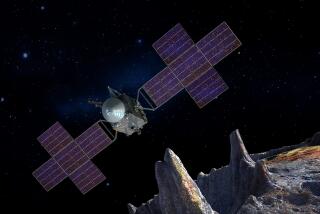The stop and go space mission
- Share via
This summer, NASA launches the Dawn mission. Dawn will visit two large asteroids, Vesta and Ceres. Dawn will go into orbit, traveling around and around each of them, one at at time.
No spacecraft has orbited two separate objects before. Why? Because to go into orbit, a spacecraft must fire its (reversed) thrusters long enough to slow down and be captured into orbit by the object’s gravity. That thrusting takes pretty much all the fuel aboard. Once in orbit, the spacecraft goes around and around the planet, never able to leave and go somewhere else because it’s out of gas. If a spacecraft tried to carry much more fuel aboard, it might be too heavy to get off the ground in the first place!
But thanks to its polite, fuel-sipping ion engines, Dawn will be able to do it all. It will go into orbit around one asteroid for a while, and have enough fuel left to leave orbit and later go into orbit around another asteroid.
On the Deep Space 1 Mission, we learned that the ion engine worked. This mission’s whole purpose was to space-test 12 new technologies, including the ion engine.
The ion engine is not like previous spacecraft engines.
Usually, a spacecraft is boosted on its journey by a big rocket, which separates and falls away once its job is done. The spacecraft then coasts the rest of the way. It fires its engines for a short time only to correct its course. Also, its engine is used when it reaches its destination (say a planet or moon), to slow down enough to be captured into orbit by the object’s gravity.
The ion engine is different. It keeps thrusting very gently for the whole journey. Because the engine pushes constantly, the spacecraft goes faster and faster.
Deep Space 1 was a mission of the New Millennium Program. The job of this NASA program is to test new technologies never before tried in space. Visit https://spaceplace.nasa.gov/en/kids/nmp/starr to read the story of “Professor Starr’s Dream Trip.” You will find out more about Deep Space 1, the Dawn mission, and how a scientist’s dream came true.
This Learning Link was written by Diane K. Fisher and provided by the Jet Propulsion Laboratory, California Institute of Technology, under a contract with the National Aeronautics and Space Administration.
More to Read
Sign up for The Wild
We’ll help you find the best places to hike, bike and run, as well as the perfect silent spots for meditation and yoga.
You may occasionally receive promotional content from the Los Angeles Times.






